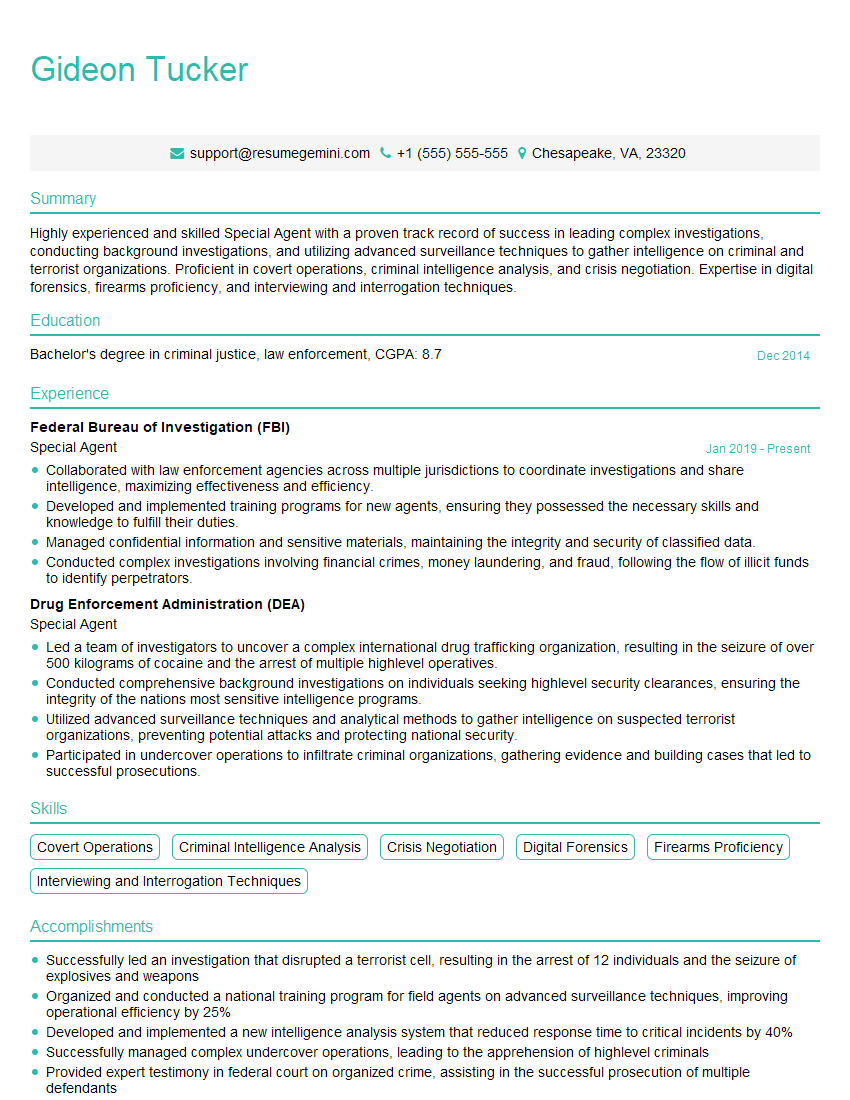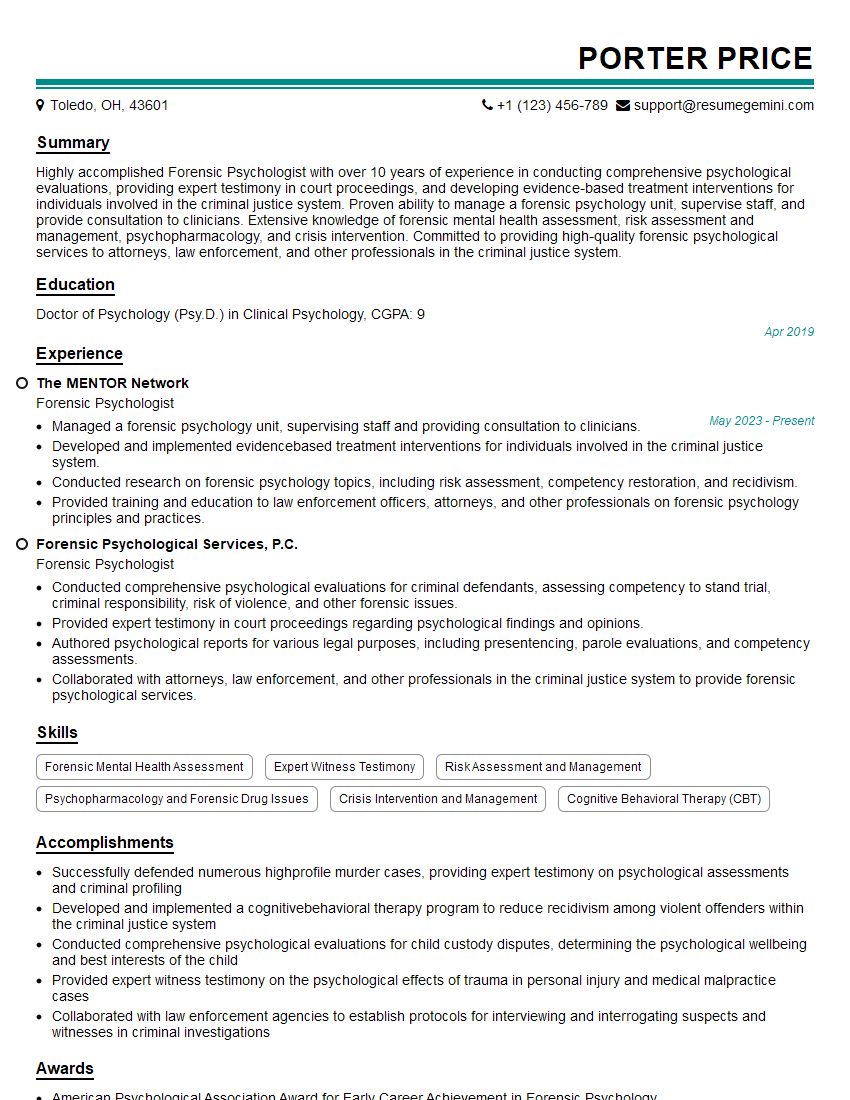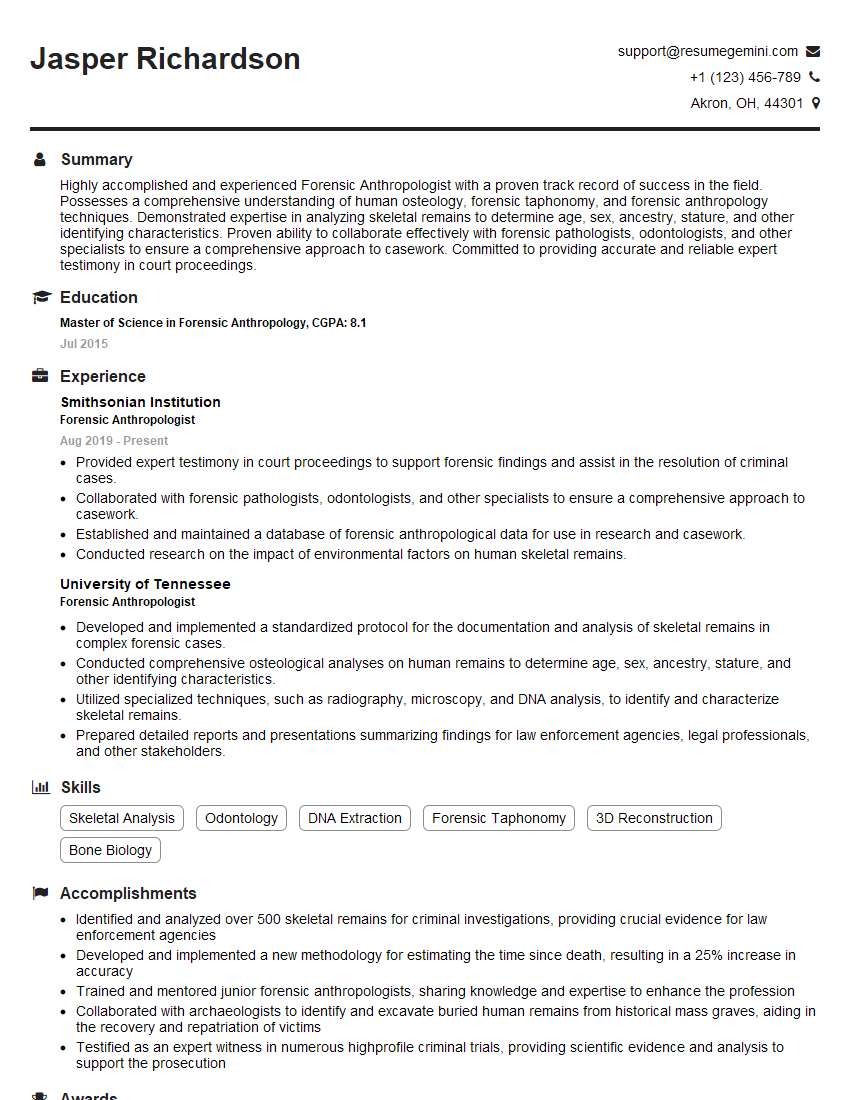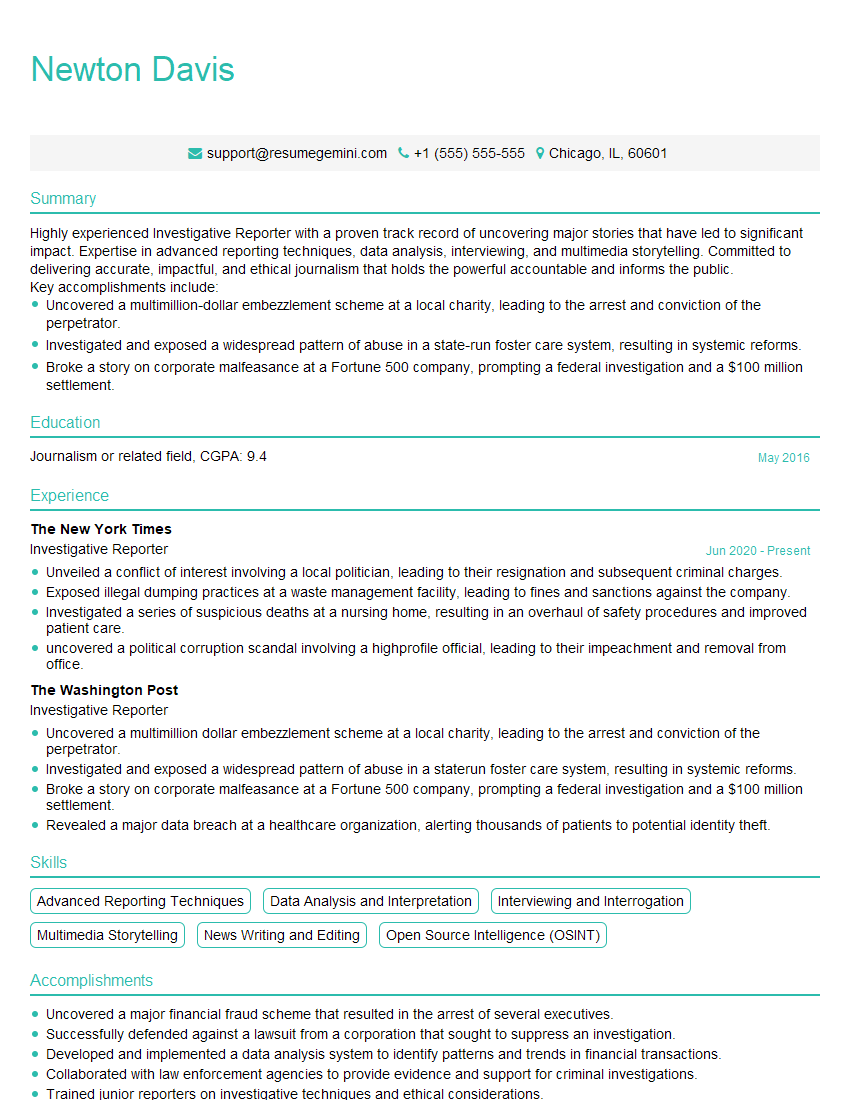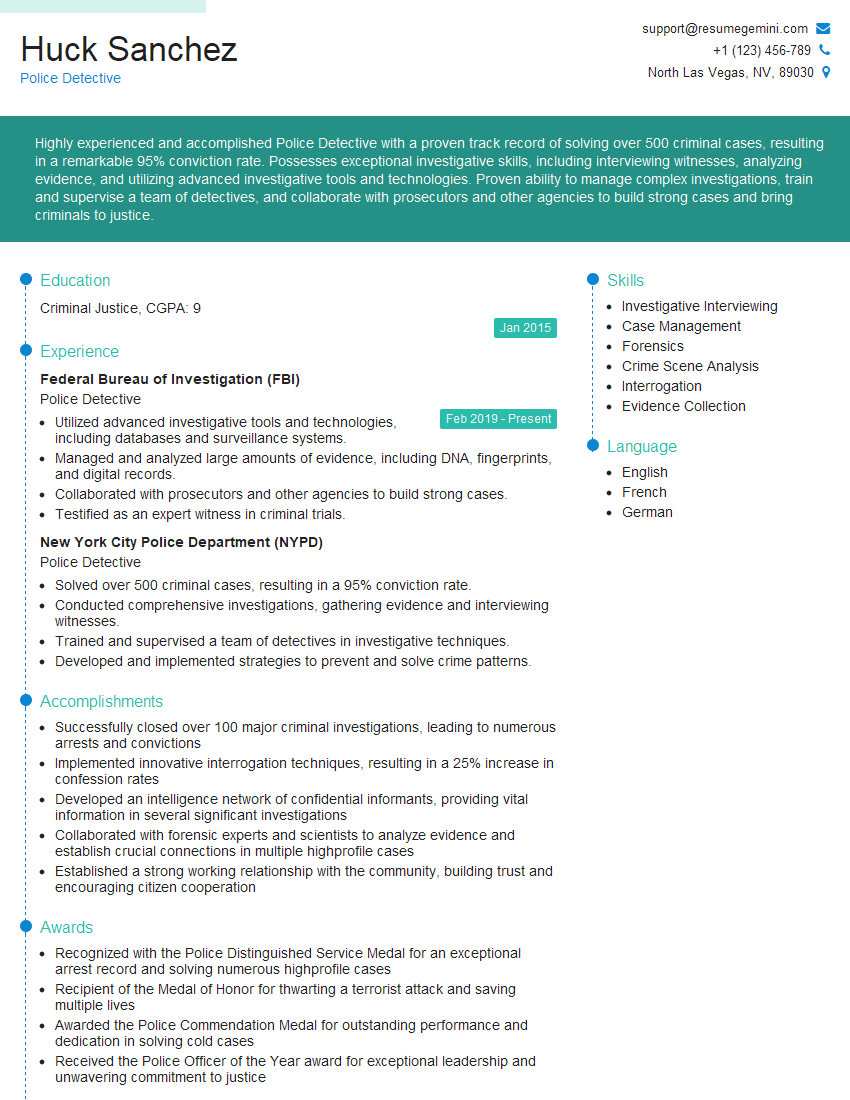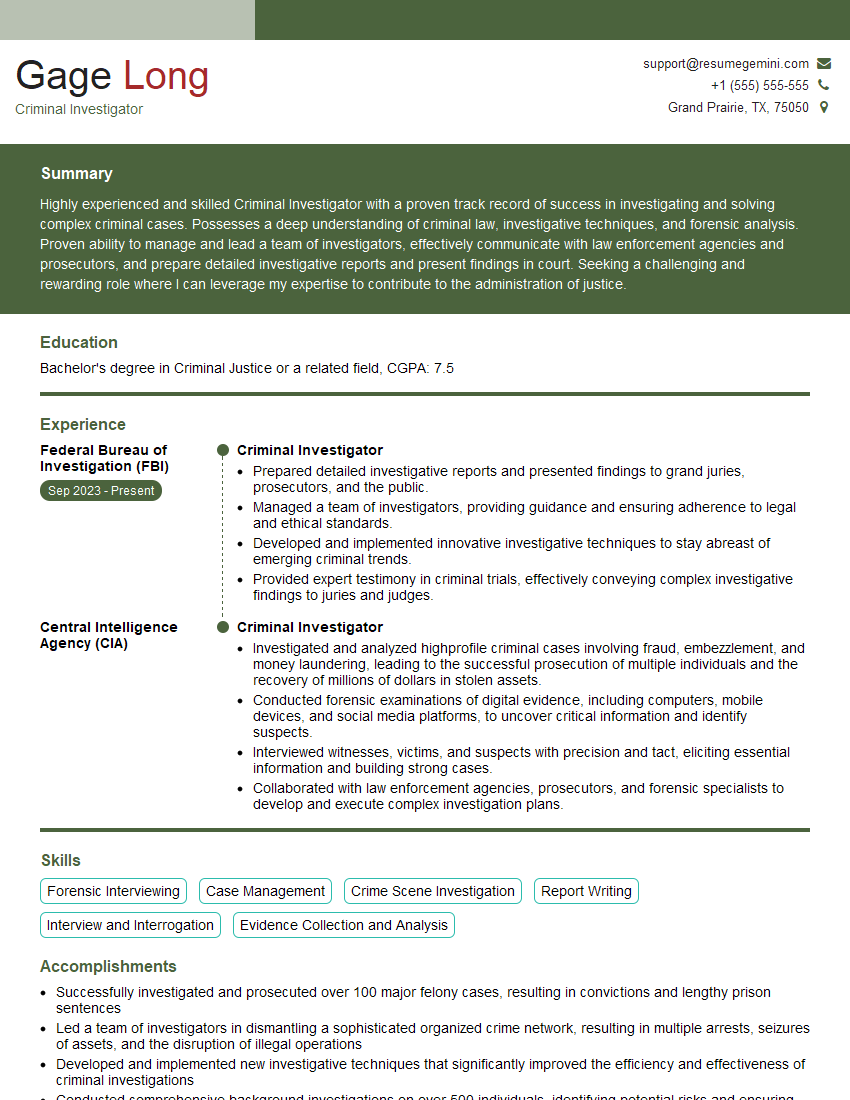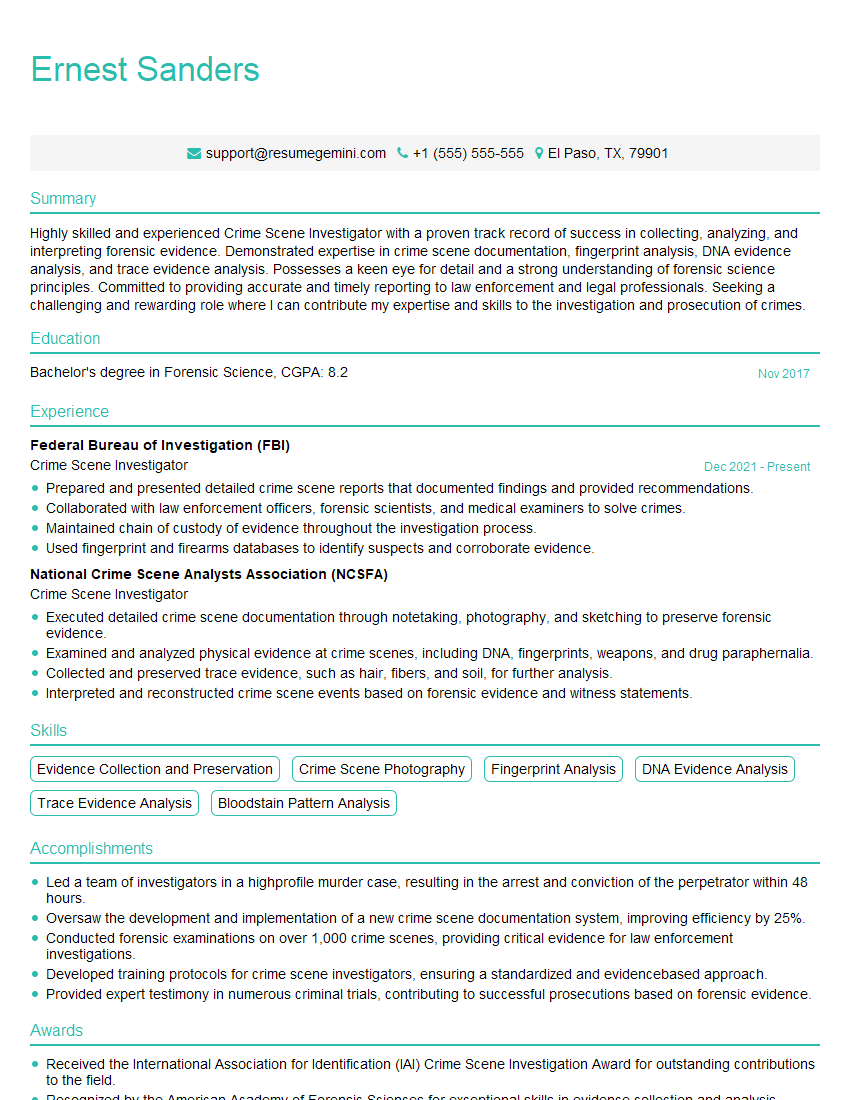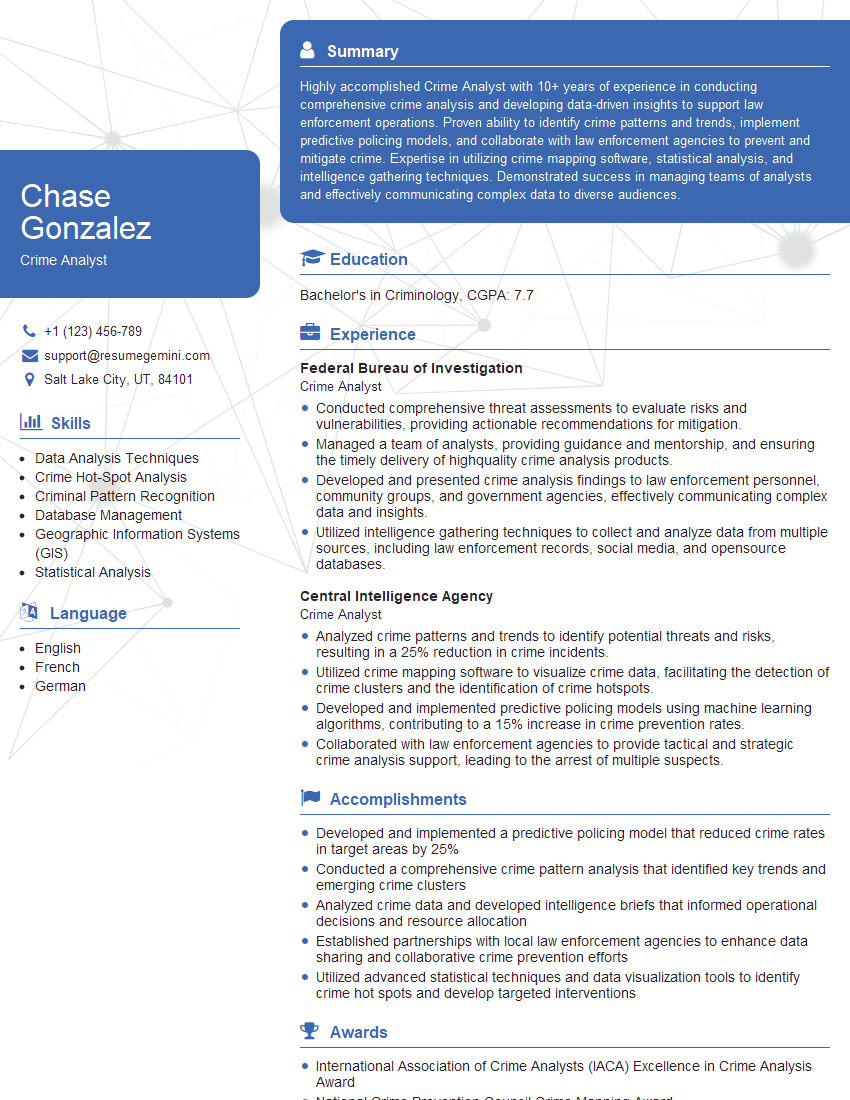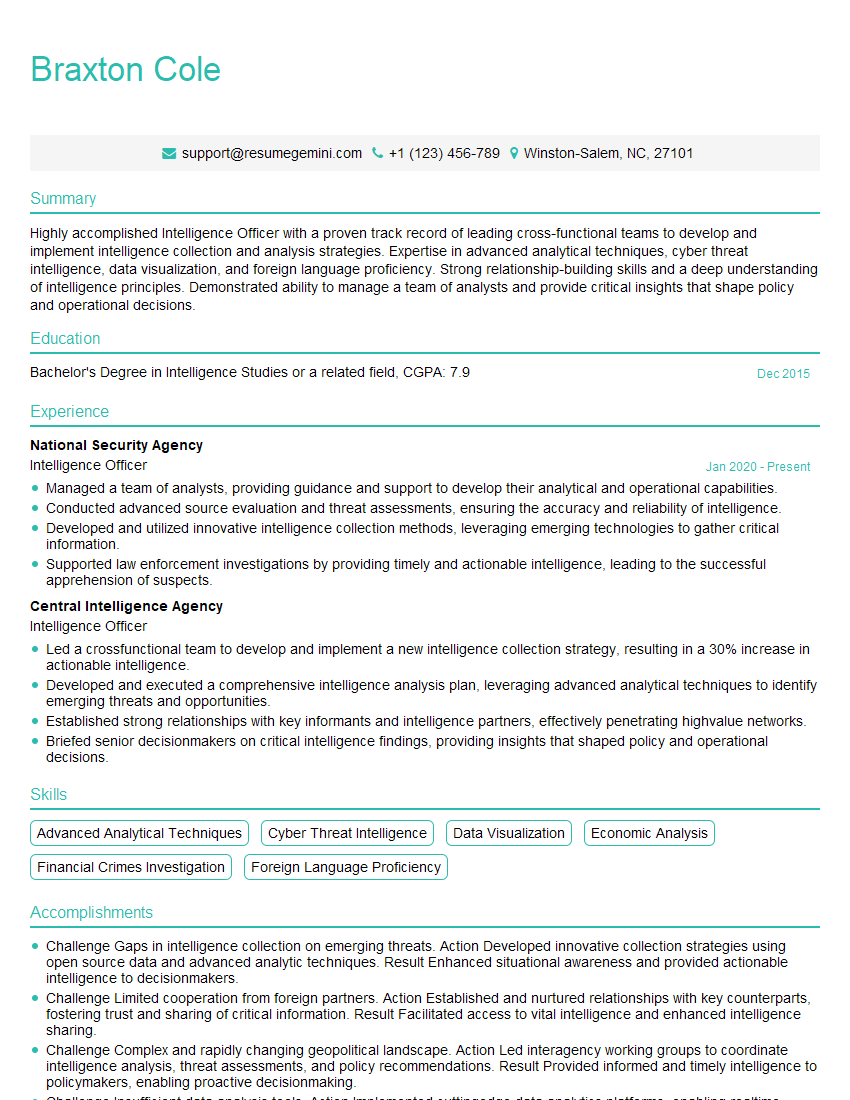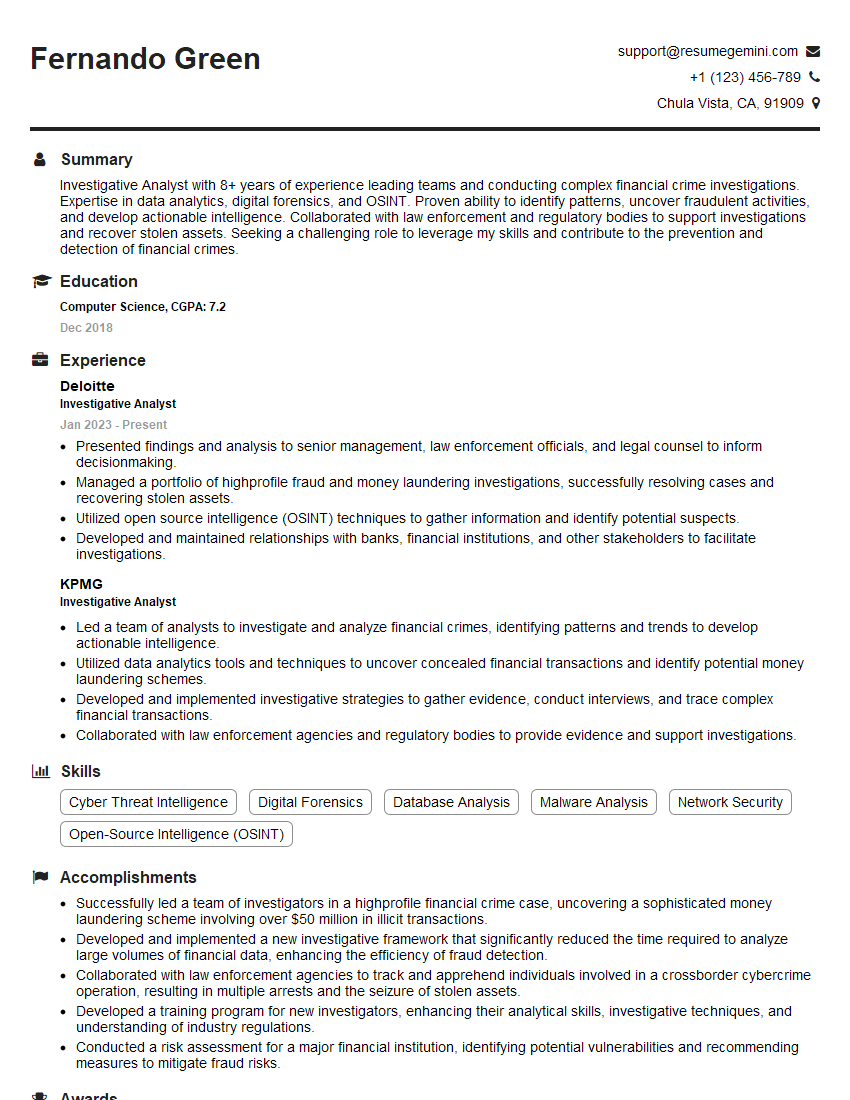Preparation is the key to success in any interview. In this post, we’ll explore crucial Offender Profiling interview questions and equip you with strategies to craft impactful answers. Whether you’re a beginner or a pro, these tips will elevate your preparation.
Questions Asked in Offender Profiling Interview
Q 1. Describe the different types of offender profiling methodologies.
Offender profiling methodologies can be broadly categorized into two main approaches: inductive and deductive profiling.
- Inductive Profiling: This approach, also known as statistical profiling, uses large datasets of known offenders to identify patterns and characteristics associated with specific crime types. It’s like creating a statistical portrait of a typical offender based on past cases. For example, analyzing data on past serial killers to identify common traits such as childhood trauma or specific methods of operation. This method is data-driven and aims to create a general profile that may not perfectly fit a particular case but offers valuable starting points for investigation.
- Deductive Profiling: This is a more case-specific approach, relying on careful analysis of the crime scene and forensic evidence to infer the offender’s characteristics, behaviors, and motivations. It’s like working backwards from the evidence to build a picture of the perpetrator. Think of a detective meticulously examining blood spatter patterns, tool marks, and victim positioning to understand the killer’s actions and personality. This method requires a deep understanding of criminal psychology and forensic science.
Beyond these core approaches, there are specialized methodologies, such as geographic profiling which focuses on the spatial patterns of the crimes, and investigative psychology, which utilizes psychological theories and principles to understand offender behavior.
Q 2. Explain the difference between geographic profiling and psychological profiling.
Geographic profiling and psychological profiling are distinct but complementary approaches in offender profiling.
- Geographic profiling focuses on the spatial aspects of the crime, analyzing the location of crime scenes to infer the offender’s likely residence, operational base, or hunting ground. Think of it as mapping the offender’s activity and using spatial analysis techniques to predict their likely location. Software and statistical methods are often employed to create probability maps.
- Psychological profiling, on the other hand, delves into the offender’s psychological characteristics, motivations, and behavioral patterns. It uses behavioral evidence from the crime scene to create a profile that includes personality traits, lifestyle, and even potential background information. For instance, analyzing the level of violence in a crime, the treatment of the victim, and the choice of weapon to infer the offender’s emotional state and potential psychopathology.
Imagine an investigation involving multiple robberies. Geographic profiling could pinpoint a likely area of residence for the offender based on the crime scene locations, while psychological profiling might reveal information about the offender’s personality—perhaps cautious, meticulous, or impulsive—based on the methods employed during the robberies.
Q 3. How do you assess the reliability of witness statements in offender profiling?
Assessing the reliability of witness statements is crucial in offender profiling. Several factors influence reliability, and a critical assessment is necessary:
- Witness Memory: Memory is fallible and subject to distortion. Stress, trauma, and time elapsed since the event can significantly impact accuracy. Techniques like cognitive interviews can help elicit more complete and accurate recollections but cannot eliminate memory distortion.
- Witness Suggestibility: Leading questions or interactions with other witnesses can inadvertently influence a witness’s testimony. Independent interviews and carefully constructed questioning are essential to mitigate this bias.
- Witness Bias: Preconceived notions, expectations, or personal experiences can color a witness’s perception and recollection of events. Understanding potential biases through thorough interviewing is crucial.
- Witness Credibility: The witness’s past behavior, potential motives, and consistency of their statements need evaluation. Inconsistencies and contradictions should be noted and investigated.
Ultimately, triangulation of evidence is crucial. Witness statements should be cross-referenced with forensic evidence, crime scene analysis, and other investigative data. No single piece of information should be relied upon solely, and independent verification is essential for building a reliable picture.
Q 4. What are the limitations of offender profiling?
Despite its valuable contributions, offender profiling has limitations:
- Subjectivity and Bias: Profilers’ interpretations of evidence can be influenced by personal biases and experiences, which might lead to inaccurate conclusions. The process relies heavily on experience and judgment, making it inherently subjective.
- Generalizability: Profiles are often based on limited data and might not apply to all cases. Offenders are diverse and don’t always neatly fit into pre-defined categories. Overreliance on stereotypes can hinder investigation.
- Lack of Empirical Validation: The effectiveness of offender profiling is difficult to quantitatively assess. Successes might be highlighted more than failures, leading to an overestimation of its accuracy.
- Circularity: A profile might reinforce pre-existing investigative biases, leading to a circular reasoning where evidence is interpreted to fit the profile rather than vice versa. This can lead to tunnel vision.
It’s crucial to acknowledge these limitations and use offender profiling as a tool that supports rather than drives the investigation. Independent verification of any conclusions is necessary.
Q 5. Discuss the ethical considerations involved in offender profiling.
Ethical considerations in offender profiling are paramount. Issues include:
- Privacy Concerns: Profiling may involve collecting and analyzing personal information, raising concerns about individual privacy rights. Strict adherence to legal and ethical guidelines regarding data collection and usage is essential.
- Potential for Bias and Discrimination: Profiles might inadvertently perpetuate stereotypes or discriminatory practices. Careful attention is necessary to avoid biased assumptions or profiling based on race, ethnicity, or other protected characteristics.
- Responsibility and Accountability: Profilers should be accountable for their work and the potential consequences of their findings. Transparency, rigorous methodology, and clear reporting are necessary to maintain accountability.
- Misuse and Misinterpretation: Profiling results can be misinterpreted or misused, potentially leading to wrongful accusations or unfair treatment. Clear communication of the limitations and uncertainties inherent in profiling is crucial.
Ethical guidelines, oversight mechanisms, and ongoing professional development are crucial in mitigating these potential risks and ensuring responsible use of offender profiling.
Q 6. How can offender profiling be integrated with other investigative techniques?
Offender profiling should not be a stand-alone technique but rather a component of a broader investigative strategy.
Integration with other techniques includes:
- Forensic Science: Integrating DNA analysis, fingerprints, and other forensic evidence with profiling insights can strengthen inferences about the offender.
- Witness Testimony: Profiling can help evaluate the credibility and reliability of witness statements by comparing them to the characteristics inferred from the profile.
- Surveillance and Intelligence: Profiling can guide surveillance efforts by providing direction in the search for suspects, based on likely behaviors or locations.
- Data Analysis: Combining profiling insights with criminal databases and intelligence sources can improve investigative efficiency.
For example, in a serial rape case, geographic profiling may narrow down the likely area of residence, while psychological profiling may suggest traits like impulsivity or narcissism. This combined information can guide detective work, informing strategies such as surveillance or targeted interviews.
Q 7. Explain the concept of ‘signature’ in offender profiling.
In offender profiling, a ‘signature’ refers to the behaviors an offender engages in beyond what is necessary to commit the crime. It reflects their psychological needs and motivations, representing a personal expression that is often consistent across their crimes.
It contrasts with ‘modus operandi’ (MO), which is the method of operation—the practical steps needed to commit the crime. The MO is primarily aimed at accomplishing the crime, whereas the signature reflects the offender’s psychological needs.
Example: In a series of burglaries, the MO might involve entering homes through unlocked windows, stealing specific items like jewelry, and leaving no trace evidence. The signature, however, might be an unusual ritualistic act performed at the crime scene, such as arranging items in a specific pattern or leaving a calling card. This signature helps identify and link crimes committed by the same individual because it is specific to their psychological profile and is unlikely to be changed by practical considerations.
Understanding the signature is crucial in linking crimes, building a psychological profile, and potentially predicting future behavior.
Q 8. How do you interpret victimology in the context of offender profiling?
Victimology, in the context of offender profiling, is the study of the victim’s characteristics and their relationship to the crime. It’s not about blaming the victim, but rather understanding their role in the crime scene and how their characteristics might have influenced the offender’s choices. We analyze factors like the victim’s lifestyle, occupation, social connections, and the location where they were victimized. For example, a victim chosen at random from a public space might suggest an opportunistic offender, whereas a victim specifically targeted based on their profession might indicate a more planned and focused crime. Understanding victimology helps us narrow down the potential offender profile, identifying potential motives and linking the crime to specific patterns.
Imagine a case where a young woman is found murdered in her home. If she had a known stalker, that drastically alters our understanding of the crime and points towards a more targeted, possibly relationship-motivated crime. Conversely, if she was a stranger in a high-crime neighborhood, we may look at patterns of opportunistic violent crime, suggesting a different type of offender.
Q 9. Describe the process of constructing an offender profile.
Constructing an offender profile is a multi-step process that relies heavily on analyzing crime scene evidence and contextual information. It begins with a thorough review of the crime scene itself. We look at the geographical location, the method of attack, the type of weapons used, the presence or absence of staging, and the overall level of organization. Next, we carefully examine the victim’s characteristics, their lifestyle, and their relationship to the offender, if any.
Then, we develop hypotheses about the offender’s likely characteristics, including their demographics (age, sex, race), psychological traits (personality, motivations), and behavioral patterns. This often involves applying known typologies, such as the organized vs. disorganized dichotomy, but always with a critical eye, acknowledging individual variability. Finally, we synthesize all the information to produce a written profile, offering likely characteristics and potential investigative leads. Think of it as building a puzzle; each piece of evidence is a clue that helps us create a picture of the offender.
Q 10. What are the key elements of a comprehensive offender profile report?
A comprehensive offender profile report should include several key elements: A detailed description of the crime scene, including the modus operandi (method of operation) and significant details. A victimology section outlining the victim’s characteristics and their connection to the crime. A detailed analysis of the offender’s characteristics, including physical appearance, personality traits, behavioral patterns, and potential motivations. A geographical profiling section analyzing the spatial patterns of the crimes to potentially identify areas of residence or operation. It should also clearly state any assumptions, limitations, and areas of uncertainty, emphasizing that the profile is a hypothesis, not a definitive statement.
In addition to these elements, the report should be concise, well-organized, and written in a style accessible to law enforcement investigators, avoiding overly technical language unless strictly necessary.
Q 11. How would you approach profiling an offender who exhibits disorganized behavior?
Profiling a disorganized offender presents a unique challenge. Their crimes tend to be impulsive, chaotic, and often reflect a lack of planning. The crime scene will typically be messy and disorganized, with little evidence of premeditation. The offender might be impulsive and emotionally driven, possibly experiencing some level of psychopathology. In approaching this profile, we’d look for patterns of impulsivity and emotional volatility in their actions. We may see evidence of overkill, suggesting a loss of control during the crime. The offender likely lives near the crime scene and might have some kind of social isolation or limited social skills. The investigative strategy should focus on identifying individuals with these characteristics who might have access to the crime scene and have potential links to the victim.
For example, if a body is discovered in a disorganized state with evidence of spontaneous violence, we might hypothesize an offender with low intelligence, poor impulse control, and possibly a history of substance abuse. The investigation would focus on local residents with these characteristics, rather than a suspect with a carefully crafted plan.
Q 12. How would you approach profiling an offender who exhibits organized behavior?
Profiling an organized offender requires a different approach. Their crimes are typically well-planned and show a high degree of control. The crime scene is often meticulously staged and reveals a level of forethought and planning. The offender might be intelligent, socially adept, and possibly have a high level of occupational stability. We’d look for evidence of meticulous planning and control, consistent behavior across different crimes, and potential indicators of occupational expertise or specific skills used in the crime. The offender likely lives some distance from the crime scene to avoid detection, suggesting a calculated and controlled approach.
Imagine a case with a meticulously staged crime scene and evidence of the offender’s attempts to conceal their identity. Here, we might hypothesize an offender with above-average intelligence, professional skills, and meticulous planning capabilities. Our investigative strategy might focus on long-distance travel patterns and potential links to a professional occupation with access to specific tools or expertise.
Q 13. Explain how technological advancements have impacted offender profiling.
Technological advancements have revolutionized offender profiling. DNA analysis, for example, has become an indispensable tool, allowing for the identification and linking of offenders across multiple crimes. Geographic Information Systems (GIS) help visualize crime patterns and identify spatial correlations that might not be apparent through traditional methods. Digital forensics plays a crucial role in analyzing electronic evidence, which can often provide crucial insights into an offender’s behavior, motivations, and interactions.
Advanced data analysis techniques, such as machine learning algorithms, are now being used to identify subtle patterns and connections in large datasets of crime information. These tools help to improve the accuracy and efficiency of the profiling process. However, it’s crucial to remember that technology is a tool, and its effectiveness depends on the expertise and judgment of the human profiler. Technology complements but doesn’t replace the human element.
Q 14. How do you handle uncertainty and incomplete information during the profiling process?
Uncertainty and incomplete information are inherent challenges in offender profiling. We deal with this by acknowledging limitations openly in the profile, clearly stating what we know and don’t know. We use probabilistic reasoning, considering the range of possibilities and assigning probabilities to different hypotheses. We rely on a thorough review of available information, even if it’s incomplete. We also utilize investigative strategies that are designed to address uncertainties. For example, we might use geographic profiling to generate a range of possible locations for the offender’s residence, rather than pinpointing one specific location.
It’s important to continually update the profile as new information becomes available. The process is iterative, not static. We never claim absolute certainty; instead, we provide a probabilistic assessment based on the best available evidence. We aim to offer the law enforcement investigators useful leads, even in cases of high uncertainty, recognizing that incomplete information is often the reality in criminal investigations.
Q 15. How can statistical analysis be utilized in offender profiling?
Statistical analysis plays a crucial role in offender profiling by allowing us to move beyond anecdotal evidence and into the realm of data-driven insights. We can analyze crime scene characteristics, victim profiles, and offender behaviors across multiple cases to identify patterns and trends. This involves various statistical methods.
- Frequency analysis: Determining how often certain characteristics (e.g., weapon type, method of entry) appear in similar crimes.
- Geographic profiling: Using spatial statistics to predict the most likely area of offender residence or operation, based on the locations of multiple crime scenes. This often involves techniques like kernel density estimation.
- Regression analysis: Examining relationships between different variables, such as the type of victim and the type of crime committed, to uncover underlying patterns.
For instance, if we notice a statistically significant correlation between a specific type of injury and a particular weapon type across multiple cases, it strengthens the profile’s accuracy. These statistical analyses help us generate more objective and reliable predictions about the offender.
Career Expert Tips:
- Ace those interviews! Prepare effectively by reviewing the Top 50 Most Common Interview Questions on ResumeGemini.
- Navigate your job search with confidence! Explore a wide range of Career Tips on ResumeGemini. Learn about common challenges and recommendations to overcome them.
- Craft the perfect resume! Master the Art of Resume Writing with ResumeGemini’s guide. Showcase your unique qualifications and achievements effectively.
- Don’t miss out on holiday savings! Build your dream resume with ResumeGemini’s ATS optimized templates.
Q 16. Discuss the role of intuition and experience in offender profiling.
Intuition and experience are invaluable, even in a data-driven field like offender profiling. While statistics provide the foundation, they don’t tell the whole story. Years of experience allow profilers to recognize subtle cues, connect seemingly disparate pieces of information, and develop a ‘feel’ for a case that is difficult to quantify statistically. It’s like a seasoned detective recognizing a familiar pattern in a complex crime scene – something that wouldn’t be apparent from a simple statistical analysis. Intuition helps in interpreting data, identifying potential biases, and making informed judgements in situations with incomplete information.
Think of it like this: statistics provides the map, but intuition guides the journey. A profiler with both strong statistical understanding and extensive experience can weave together data and intuition to create a more complete and accurate profile.
Q 17. Describe a case where offender profiling proved to be particularly effective.
The case of the ‘Yorkshire Ripper’ (Peter Sutcliffe) demonstrates the effectiveness of offender profiling, although with some limitations. Initially, police investigations were hampered by inconsistent information and a lack of clear patterns. However, using geographic profiling and behavioral analysis, Robert Ressler and other profilers were able to narrow down the possible area of the offender’s residence. While the profile wasn’t perfectly accurate in predicting all aspects of the offender, the narrowed geographic focus proved crucial in ultimately leading to Sutcliffe’s arrest. This highlights how profiling can help prioritize leads and focus investigative efforts, even when dealing with complex and evolving crime scenes.
Q 18. Describe a case where offender profiling proved to be less effective and why.
Not all cases yield successful offender profiling. The case of the ‘Son of Sam’ (David Berkowitz) is a prime example. While profiling efforts were undertaken, the profile generated didn’t accurately predict Berkowitz’s characteristics or behavior. This failure was partly due to the highly unusual and seemingly random nature of his crimes, which didn’t fit established patterns. The offender was also more geographically mobile than predicted, confounding geographic profiling efforts. This underlines the importance of acknowledging the limitations of profiling; it is a tool, not a crystal ball, and its success hinges on the nature and quality of the available data. Unpredictable or highly unusual criminal behavior can make successful profiling very challenging.
Q 19. What are the common pitfalls in offender profiling?
Several pitfalls can affect the accuracy and objectivity of offender profiling:
- Confirmation bias: The tendency to seek out information that confirms pre-existing beliefs and overlook contradictory evidence.
- Overreliance on stereotypes: Assuming that offenders fit pre-conceived notions based on age, race, or other demographic factors.
- Insufficient data: Attempting to create a profile with limited or incomplete information from the crime scene or victim.
- Ignoring contextual factors: Failing to consider the specific social, economic, and environmental circumstances influencing the crime.
- False positives: Mistakenly identifying an individual as a suspect based on a superficial resemblance to the profile.
Careful attention to methodology, a rigorous review process, and awareness of these biases are essential to mitigate these risks.
Q 20. How do you ensure the objectivity and accuracy of your profiling conclusions?
Maintaining objectivity and accuracy requires a multi-faceted approach. First, relying on a systematic and standardized approach, such as structured investigative methods, helps minimize bias. Second, using a team approach, with multiple profilers reviewing and critically evaluating each other’s work, facilitates a more objective assessment. Third, regularly reviewing and updating the profile based on new information helps ensure that it remains grounded in evidence. Finally, meticulously documenting all the steps in the profiling process ensures transparency and allows for rigorous scrutiny. By meticulously documenting the rationale behind each conclusion, we can strengthen the validity of our findings.
Q 21. How do you manage the emotional demands of working with violent crime cases?
Working with violent crime cases can be emotionally taxing. Victims’ stories and the sheer brutality of some crimes can be profoundly disturbing. Effective coping mechanisms are crucial for maintaining professional objectivity and preventing burnout. This often involves:
- Regular supervision and debriefing: Discussing cases with colleagues and supervisors provides a supportive environment to process difficult emotions.
- Self-care strategies: Engaging in activities such as exercise, mindfulness, or spending time with loved ones helps maintain emotional balance.
- Professional boundaries: Maintaining a professional distance from cases is essential to prevent emotional entanglement, which could negatively impact objectivity.
- Seeking professional support: Accessing mental health resources for support and guidance when needed.
Recognizing the emotional toll of the work and proactively implementing these strategies are crucial for long-term professional wellbeing.
Q 22. Describe your experience with different types of crime scenes (e.g., homicide, sexual assault).
My experience encompasses a wide range of crime scenes, from intimate and often emotionally charged sexual assault cases to the more overtly violent and complex dynamics of homicide investigations. In sexual assault cases, I focus on identifying behavioral patterns—the offender’s approach, the level of control exerted, the presence or absence of premeditation, and the type of post-offense behavior. These details, often subtle, provide crucial insights into the offender’s personality and modus operandi. For example, the use of restraints might indicate a need for control, while the presence of specific paraphernalia could suggest fetishistic tendencies. In homicide cases, the scene’s staging—how the body is positioned, the presence of any ritualistic elements, and the type of weapon used—offers critical clues. The level of violence inflicted can indicate the offender’s anger management or emotional state. One case I recall involved a meticulously staged homicide; the precision suggested a high degree of planning and a possible need for control, leading to a profile emphasizing meticulousness and organizational skills.
The differences between these crime scenes aren’t simply in the level of violence. Homicides often reveal more about the offender’s relationship with the victim, while sexual assaults may be more focused on the offender’s power dynamics and sexual fantasies. Analyzing both meticulously, looking for inconsistencies and recurring themes, is vital to creating an accurate profile.
Q 23. How do you utilize investigative databases and resources in your profiling work?
Investigative databases and resources are indispensable tools in my work. I utilize national and international databases containing information on past crimes, offender profiles, DNA evidence, and forensic findings. For instance, the Violent Criminal Apprehension Program (ViCAP) database helps identify similarities between unsolved cases, potentially linking crimes committed by the same individual across jurisdictions. I also use geographical profiling software to analyze crime locations and predict the offender’s likely residence or operational base. This software uses algorithms to map the spatial patterns of crimes, factoring in factors such as travel time and the offender’s likely comfort zones. Access to these resources allows me to compare current cases with past ones, identify patterns, and develop a more accurate profile by leveraging the collective intelligence gathered over time. Often, finding a previously unsolved case with strikingly similar characteristics to the current investigation provides invaluable insight.
Beyond databases, resources like psychological literature, forensic reports and expert witness testimony enrich the profiling process. For instance, the literature on psychopathy can inform my understanding of offenders with callous and unemotional traits, and forensic reports offer crucial contextual information on the crime itself.
Q 24. Explain your familiarity with different personality assessment tools.
My familiarity with personality assessment tools is extensive. I don’t rely on any single test, as each has limitations. However, understanding the theoretical underpinnings of various tools is crucial. I frequently utilize the principles behind the MMPI (Minnesota Multiphasic Personality Inventory) and the PCL-R (Psychopathy Checklist-Revised) to understand the personality structure of offenders. While I don’t administer these tests directly—that’s typically the role of a clinical psychologist—I incorporate the information from such assessments (if available) into my profiling process. The understanding of constructs such as narcissism, antisocial personality disorder, and psychopathy allows me to interpret behavioral patterns observed at the crime scene and integrate them into a comprehensive profile. For instance, a high score on the PCL-R’s factor 1 (interpersonal/affective traits) suggests a manipulative and callous offender, influencing predictions about their behavior in future crimes. It is critical to remember, though, that these assessments are tools to be interpreted cautiously and within their contextual limitations.
Q 25. How do you collaborate effectively with other members of an investigative team?
Effective collaboration is paramount in offender profiling. I view myself as a consultant to the investigative team, not the leader. My role is to contribute my specialized knowledge and analysis, working closely with detectives, forensic experts, and other specialists. Open communication and a shared understanding of the investigative goals are essential. I actively participate in team meetings, providing updates on my profile development and offering insights that may guide the direction of the investigation. For example, my profile might suggest specific lines of inquiry for detectives, help narrow down the suspect pool, or suggest locations to search. I always present my findings transparently, acknowledging limitations and emphasizing the probabilistic nature of profiling. Regular feedback loops ensure that my conclusions remain relevant to the evolving investigation.
A successful collaboration depends on mutual respect and trust. I value input from other team members, as their perspectives and experiences often provide valuable insights I might otherwise overlook.
Q 26. Explain your understanding of the legal framework surrounding the use of offender profiling in investigations.
Understanding the legal framework surrounding offender profiling is crucial. My work must always adhere to legal standards of evidence and due process. Profiling conclusions should not be presented as definitive proof of guilt but rather as investigative leads to assist in narrowing down the suspect pool. For example, a profile suggesting an offender possesses certain traits doesn’t automatically justify arresting anyone who fits that description. It needs to be integrated with other evidence to support an arrest and subsequent prosecution. Furthermore, the disclosure of profiling information must be handled carefully to avoid compromising the investigation or unfairly prejudicing potential suspects. Maintaining transparency and ethical conduct is paramount, and understanding the legal parameters ensures that my work is both helpful and legally sound.
Q 27. How would you handle criticism of your profiling conclusions?
Criticism of my profiling conclusions is expected and, in many ways, beneficial. It encourages critical self-reflection and helps refine my methodology. I handle criticism by first acknowledging the concerns and seeking to understand their basis. If the criticism is valid and points to flaws in my reasoning or data interpretation, I would revise my conclusions accordingly. I document my rationale, including all data considered and the limitations of the profiling process. This documentation allows for a transparent review of my work and facilitates constructive dialogue. When the criticism is based on misconceptions about offender profiling’s limitations, I strive to provide education and clarify the role of profiling within the broader investigative context. The goal isn’t to be infallible but to learn from mistakes and continually improve the accuracy and reliability of my work.
Q 28. How do you stay updated on the latest advancements in the field of offender profiling?
Staying updated in offender profiling requires continuous professional development. I actively participate in professional organizations, attend conferences and workshops, and read peer-reviewed journals on forensic psychology, criminology, and related fields. Networking with other experts is crucial for exchanging knowledge and insights. I continuously review new research, particularly those investigating the effectiveness and limitations of various profiling techniques and methodologies. It’s essential to be aware of emerging technologies that may aid the profiling process, such as advanced data analytics and AI-driven tools for crime scene analysis and geographic profiling. Keeping abreast of new research and best practices is crucial to maintaining competence and providing the highest quality service to law enforcement.
Key Topics to Learn for Offender Profiling Interview
- Geographic Profiling: Understanding spatial patterns of criminal behavior and its application in narrowing down suspect locations. Practical application includes analyzing crime scene locations using mapping software and interpreting spatial data.
- Behavioral Analysis: Identifying behavioral patterns, motivations, and characteristics of offenders based on crime scene evidence and investigative data. Practical application involves interpreting forensic evidence to build a psychological profile of the offender.
- Investigative Psychology: Applying psychological principles to criminal investigations, including offender profiling, victimology, and witness testimony analysis. Explore the different models of investigative psychology and their practical limitations.
- Criminal Investigative Analysis: Utilizing a range of investigative techniques and analytical methods to develop offender profiles and support criminal investigations. This includes understanding the difference between inductive and deductive profiling methodologies.
- Case Study Analysis: Critically evaluating real-world case studies to understand the successes and limitations of offender profiling techniques. Focus on analyzing the methods used, their strengths and weaknesses, and the overall outcomes.
- Ethical Considerations: Understanding the ethical implications of offender profiling and its potential biases. This includes the responsible use of profiling data and avoiding discriminatory practices.
- Interviewing and Interrogation Techniques: Familiarizing yourself with effective strategies for interviewing suspects and witnesses based on the developed profiles. This includes understanding the nuances of communication and establishing rapport.
Next Steps
Mastering Offender Profiling opens doors to a rewarding career in law enforcement, forensic psychology, and criminal justice. To maximize your job prospects, crafting a compelling and ATS-friendly resume is crucial. ResumeGemini can significantly enhance your resume-building experience, providing the tools and resources to present your skills and experience effectively. We offer examples of resumes tailored specifically to Offender Profiling to help you showcase your qualifications. Take the next step towards your dream career; build a standout resume with ResumeGemini today.
Explore more articles
Users Rating of Our Blogs
Share Your Experience
We value your feedback! Please rate our content and share your thoughts (optional).
What Readers Say About Our Blog
This was kind of a unique content I found around the specialized skills. Very helpful questions and good detailed answers.
Very Helpful blog, thank you Interviewgemini team.

